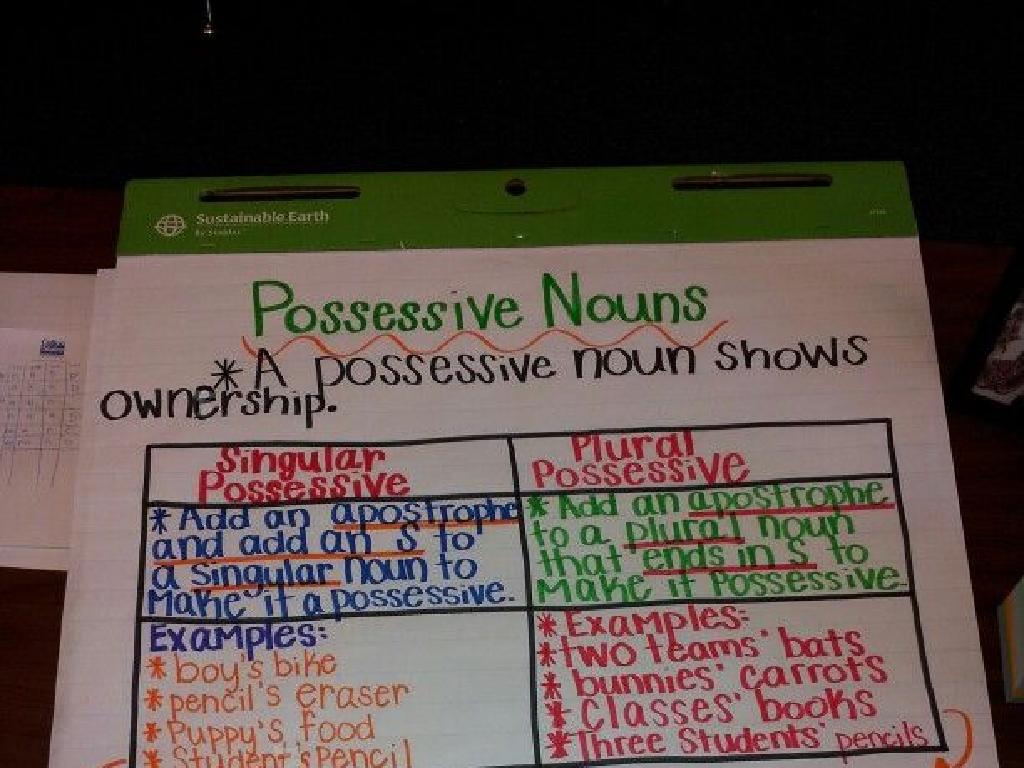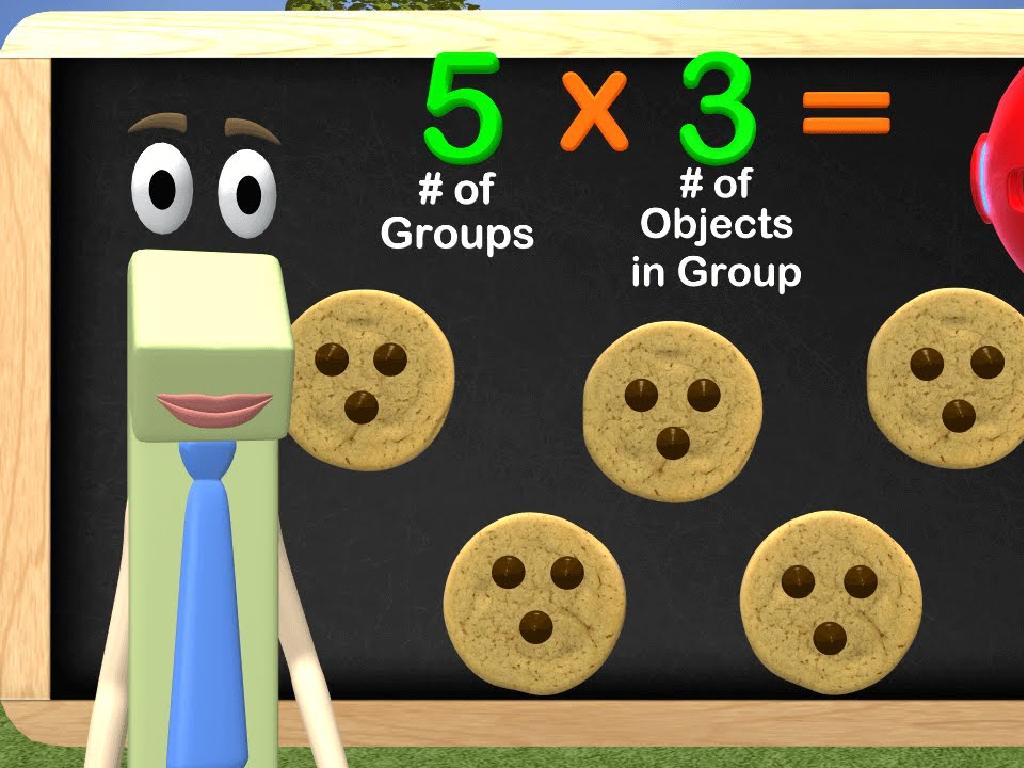Order Numbers
Subject: Math
Grade: Third grade
Topic: Ordering And Comparing
Please LOG IN to download the presentation. Access is available to registered users only.
View More Content
Introduction to Ordering Numbers
– Understanding number order
– Ordering means arranging numbers from smallest to largest or vice versa.
– Importance of number order
– Knowing the order helps in counting, comparing, and understanding value.
– Learning to arrange numbers
– We’ll practice sorting numbers in different ways using fun activities.
|
This slide introduces the concept of ordering numbers, which is a fundamental skill in mathematics. It’s crucial for students to understand that numbers can be arranged in a sequence based on their value. This knowledge is applied in various aspects of math, such as counting, comparing quantities, and performing arithmetic operations. Today’s lesson will focus on engaging the students with interactive activities that will help them learn how to arrange numbers both in ascending and descending order. Encourage the students to think about situations where they have to line up or arrange things based on size or quantity to relate to the concept of ordering numbers.
Understanding Number Value
– Every number has a place value
– Place value determines the value of a digit in a number
– Compare numbers on a number line
– A number line helps us see the order of numbers visually
– Decide which number is bigger
– Comparing numbers: which is larger, 23 or 32?
– Practice with examples
– Let’s order 15, 29, and 34 from smallest to largest
|
This slide introduces the concept of place value and how it can be used to order and compare numbers. Emphasize that the position of a digit in a number determines its value. Introduce the number line as a tool for visual comparison. Use examples to show how to determine which number is larger or smaller by looking at the place value of each digit. Encourage students to practice with provided examples and to think of their own sets of numbers to compare. This will help solidify their understanding of number value and comparison.
Understanding Ascending Order
– Ascending order: smallest to largest
– Start with the lowest number and go to the highest, like 2, 5, 9.
– Like climbing a ladder: step by step
– Each step on a ladder is like moving to the next higher number.
– Practice arranging numbers
– Let’s sort 3, 1, 4 into 1, 3, 4 together.
– Visualize with number lines
– A number line helps us see the order clearly.
|
This slide introduces the concept of ascending order to third-grade students, comparing it to the familiar action of climbing a ladder. Emphasize that just as we climb from the bottom to the top of a ladder, we arrange numbers from the smallest to the largest. Encourage students to visualize this process using a number line and to practice with actual numbers. Provide several examples and use a number line diagram to reinforce the concept. During the next class, have students practice by arranging sets of numbers in ascending order and explain their thought process.
Arranging Numbers in Descending Order
– Descending order: big to small
– Start with the largest number and go to the smallest.
– Like going down a slide
– Imagine starting at the top of a slide and sliding down.
– Let’s arrange numbers!
– We’ll line up numbers from highest to lowest.
– Practice with examples
– Try arranging 65, 29, 87, and 34 in descending order.
|
This slide introduces the concept of descending order to third-grade students by comparing it to the familiar activity of going down a slide. It’s a visual and intuitive way to help them understand that descending order starts with the biggest number and ends with the smallest. Provide several examples of number sets for the students to arrange in descending order, and encourage them to visualize the numbers as if they were on steps, going from the highest step down to the lowest. This will help solidify their understanding of the concept. In the next class, review their arrangements and discuss any challenges they faced.
Using Place Value to Order Numbers
– Understanding place value
– Each digit has a value based on its position
– Comparing numbers with place value
– Look at the highest place value to compare
– Ordering numbers correctly
– Arrange numbers from smallest to largest
– Examples of ordering numbers
– 253, 325, 235: Which is largest?
|
This slide introduces the concept of place value as a foundation for ordering numbers. Emphasize that each digit in a number has a specific value depending on its position. When comparing numbers, students should start with the highest place value and work their way down to the smallest. Provide examples of numbers that have the same digits but different place values and ask students to order them. Encourage students to practice by picking random numbers and arranging them in both ascending and descending order. This will help solidify their understanding of place value and its role in comparing and ordering numbers.
Practice Time: Ordering Numbers
– Arrange numbers in ascending order
– Ascending order means from smallest to largest
– Practice with given numbers
– Arrange numbers in descending order
– Descending order means from largest to smallest
– Share your answers with the class
|
This slide is for a class activity where students will practice ordering numbers. Start by explaining that arranging numbers in ascending order means starting with the smallest number and going to the largest. Provide a set of numbers for the students to arrange, such as 8, 3, 5, 1, and 4. Then, ask them to rearrange the same numbers in descending order, starting with the largest number. Encourage students to check their work with a partner before sharing their answers with the class. Possible activities could include using number cards, interactive whiteboard exercises, or a worksheet. This will help reinforce their understanding of numerical order and prepare them for more complex math concepts.
Class Activity: Number Ordering Race
– Race to order numbers quickly
– Receive a set of numbers
– Arrange them ascending & descending
– From smallest to largest & largest to smallest
– Compete to be the champion
|
This activity is designed to make learning fun and interactive by incorporating a competitive element. Each student will receive a random set of numbers and will be tasked with arranging them in both ascending (from smallest to largest) and descending (from largest to smallest) order. This will help reinforce their understanding of numerical order. To manage this activity, prepare sets of numbers in advance, ensure each set has a varied range of numbers, and provide clear instructions. Consider having multiple rounds to allow students multiple attempts to improve their speed and accuracy. Offer encouragement and praise to all participants for their effort and celebrate the ‘champions’ who complete the task the fastest. This activity not only helps with number ordering skills but also promotes a healthy competitive spirit and engagement in the classroom.
Conclusion: Ordering Numbers
– Recap on ordering numbers
– We learned how to arrange numbers from smallest to largest and vice versa.
– Importance of number order
– Ordering helps in daily tasks like organizing, budgeting, and scheduling.
– Celebrate today’s learning
– Encouragement to practice
– Keep practicing with more numbers to get even better!
|
Today, we’ve covered how to order numbers, which is a fundamental skill in math that helps with understanding numerical relationships. We discussed how this skill is not just for math class but is also used in everyday life, such as when we line up, sort items, or plan events. It’s important to emphasize to the students that mastering ordering numbers will make other math concepts easier to understand. As we wrap up, let’s acknowledge the hard work the students put in today and remind them that with regular practice, they’ll become even more confident in their ability to order numbers.






